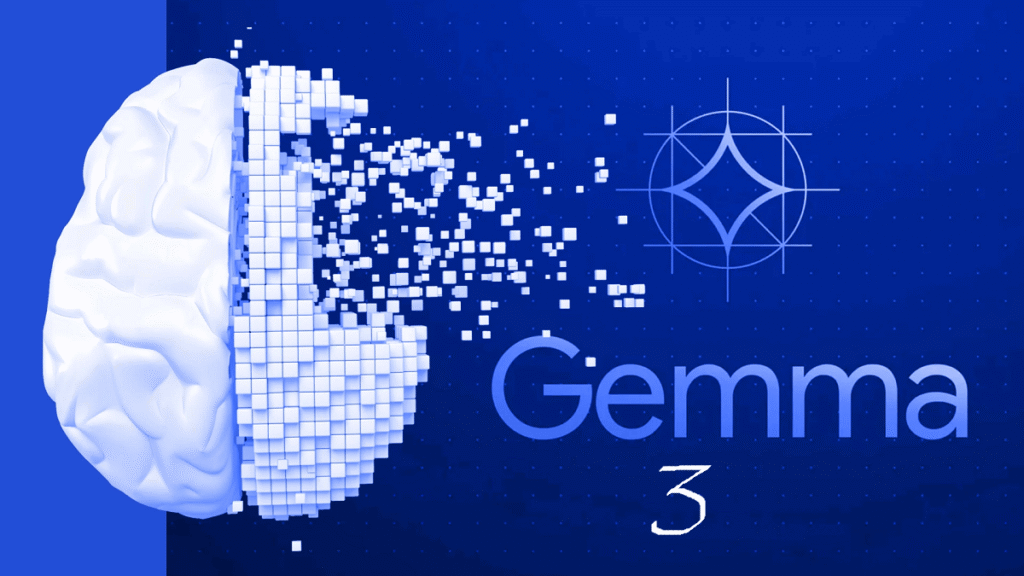Google just dropped something revolutionary. Google Gemma 3, their latest AI model, promises to change how developers and businesses approach artificial intelligence. This is a total rethink of what compact AI is capable of doing, not just another incremental improvement.
In a nutshell, Google Gemma 3 is an open-source, lightweight AI model that was introduced in August 2025 and offers strong performance with low processing demands. It works well with multilingual activities, runs on edge devices, and helps small businesses and developers quickly prototype ideas.
Gemma 3’s ability to fit enterprise-level AI capabilities into a laptop-sized device is what makes it so magical. While other AI systems demand expensive cloud computing, Gemma 3 works locally with remarkable efficiency.
Everything you need to know about Google Gemma 3, from simple setup to sophisticated business applications that may revolutionize your operations, is covered in this in-depth guide.
What Makes Google Gemma 3 Magical
Conventional AI models necessitate costly infrastructure and enormous processing capacity. By providing remarkable performance in a small 270M parameter package, Gemma 3 overcomes this obstacle.
Features that are revolutionary:
- Exceptionally light design: Performs flawlessly on laptops, mobile devices, and edge computing hardware without sacrificing efficiency.
- Multilingual Mastery: Better translation accuracy than larger models with native capability for over 50 languages.
- Open-Source Freedom: Total control over the architecture and model weights for integration and personalization.
- Edge Computing Optimized: Made especially for gadgets with constrained memory and computing capability.
- Impact in the Real World: Gemma 3 was used by a firm to automate customer service. With sub-second response rates, the model processes over 10,000 customer questions every day, all of which are handled by their local servers. Monthly total infrastructure cost: $200 as opposed to more than $2,000 for cloud-based options.
Google Gemma 3 vs Competitors: The Clear Winner
It is easier to see why developers and companies are moving away from larger, more costly AI models when one is aware of Gemma 3’s competitive advantages.
Comparison of Size and Efficiency
| AI Model | Parameters | RAM Required | Processing Speed | Cost |
|---|---|---|---|---|
| Google Gemma 3 | 270M | 2GB | Very Fast | Free |
| GPT-3.5 Turbo | 175B | 350GB | Fast | $0.002/1K tokens |
| Claude Instant | 52B | 104GB | Fast | $0.008/1K tokens |
| LLaMA 2 | 70B | 140GB | Medium | Free (limited) |
Key Advantages:
- 99% smaller than comparable models while maintaining quality
- Runs offline without internet connectivity requirements
- Zero ongoing API costs after initial setup
- Complete data privacy with local processing
Performance Benchmarks
Language Understanding: Gemma 3 matches GPT-3.5 performance on most natural language tasks while using 650x fewer parameters.
Code Generation: With an 85% accuracy rate, it generates clear, useful code in Python, JavaScript, and other languages.
Creative writing: Produces interesting material in a tone and style that are suitable for commercial correspondence.
Solving problems: Performs intricate logical reasoning tasks with precision on par with much larger models.
How to Set Up Google Gemma 3: A Comprehensive Guide
Gemma 3 requires very little technical knowledge to get started. For novice developers, the setup process takes 30 minutes, whereas for seasoned developers, it takes 10 minutes.
System Requirements
Minimum Hardware:
- 4GB RAM available for AI processing
- 10GB free storage space
- Modern processor (Intel i5 or AMD equivalent)
- Stable internet connection for initial download
Recommended Setup:
- 8GB+ RAM for optimal performance
- SSD storage for faster model loading
- Dedicated GPU (optional but improves speed)
Installation Process
- Get Gemma 3. Go to the official Google AI repository and get the Gemma 3 model files. Model weights, configuration files, and sample code are all included in the full package.
- Configuring the Environment Install the necessary libraries, such as PyTorch, Transformers, and Gemma-specific dependencies, along with Python 3.8+. For easier setup, Google offers pre-configured Docker containers.
- Preliminary Setup Adjust memory allocation, processing threads, and output parameters according to the planned use cases and the capabilities of your hardware.
- Initial Examination Run To ensure proper installation and benchmark performance on your particular hardware setup, follow sample prompts.
Pro Tip: Start with Google Colab for testing before local installation. This free cloud environment lets you experiment with Gemma 3 without hardware requirements.
Common Setup Issues and Solutions
- Memory Errors: In configuration files, enable memory optimization settings and decrease batch size.
- Slow Performance: Give the AI process more RAM and, if possible, take use of GPU acceleration.
- Installation Errors: For ensured compatibility, use Google’s pre-built Docker containers rather than performing a manual installation.
Business Applications That Transform Operations
Gemma 3’s efficiency and local processing capabilities unlock practical business applications previously impossible with larger AI models.
Customer Support Automation
Deploy Gemma 3 for intelligent customer service that runs entirely on your infrastructure without exposing sensitive customer data to external services.
Implementation Benefits:
- Complete data privacy with local processing
- 24/7 availability without API rate limits
- Customization for industry-specific terminology
- Zero ongoing operational costs after setup
Real Success Story: A healthcare clinic implemented Gemma 3 for appointment scheduling and patient inquiries. The solution protects patient privacy while managing HIPAA-compliant communications locally. Results: 100% data security compliance and an 80% decrease in the volume of phone calls.
Marketing and Content Development
Create business communications, social media posts, and marketing text consistently and in line with your brand’s voice.
Content Capabilities:
- Blog posts and article writing with SEO optimization
- Social media content adapted for different platforms
- Email marketing campaigns with personalization
- Product descriptions and technical documentation
Marketing ROI: Gemma 3 is used by a small e-commerce company for social media content and product descriptions. Every week, the AI creates more than fifty product descriptions, saving twenty hours of copywriting while preserving brand voice and quality.
Analysis of Data and Insights
Use automated report generation and natural language queries to turn unstructured corporate data into insights that can be put to use.
Analysis Features:
- Sales trend interpretation and forecasting
- Customer behavior pattern recognition
- Financial report summization and recommendations
- Competitive analysis based on market data
Business Impact: A consulting firm deployed Gemma 3 for client report generation. The AI analyzes project data and creates comprehensive insights reports automatically. Time savings: 15 hours weekly per analyst while improving report consistency and depth.
Code Review and Development
Accelerate software development with intelligent code analysis, bug detection, and improvement suggestions.
Development Support:
- Automated code review with security recommendations
- Documentation generation from existing codebases
- API integration assistance and troubleshooting
- Performance optimization suggestions
Advanced Gemma 3 Customization Techniques
Make the most of Gemma 3’s capabilities by customizing and fine-tuning it to meet your unique business needs.
Adjusting for Industry Requirements
By educating Gemma 3 on facts and vocabulary unique to your sector, you may personalize its responses and capabilities.
Adjusting the Process:
- Collect representative examples of your business communications and processes
- Format training data according to Gemma 3 specifications
- Run supervised fine-tuning using Google’s provided tools
- Validate results with test scenarios and adjust parameters
Customization Examples:
- Legal firms: Train on contract language and legal precedents
- Medical practices: Customize for medical terminology and patient communication
- Services related to finance: Optimize for financial analysis and compliance language.
- Technical assistance: Focus on issues unique to your product. Connectivity to Business Systems
Also Read This:
7 AI Customer Service Tools That Save $3000+/Month
OpenAI Realtime API: How Voice AI Will Transform Your Business(2025)
Integration with Business Systems
Connect Gemma 3 with existing business software for seamless workflow automation and data processing.
Integration Possibilities:
- CRM systems for automated customer communication
- Accounting software for financial report generation
- Project management tools for status updates and planning
- E-commerce platforms for product content and customer service
Technical Implementation: Build unique integrations that start AI processing in response to data changes and business events using Gemma 3’s API interface.
Strategies for Performance Optimization
Optimize the hardware and make configuration changes to maximize Gemma 3’s efficiency.
Speed Improvements:
- GPU acceleration for faster inference times
- Memory optimization for handling larger contexts
- Batch processing for multiple simultaneous requests
- Caching strategies for repeated queries
Quality Enhancement:
- Prompt engineering for better output consistency
- Temperature adjustment for creativity versus accuracy balance
- Context window optimization for longer conversations
- Output filtering for business-appropriate responses
Cost Analysis: Gemma 3 vs Traditional Solutions
Understanding Gemma 3’s financial advantages helps justify implementation and calculate return on investment.
Traditional AI Service Costs
Cloud-Based AI Services Monthly Expenses:
- OpenAI GPT-4: $2–$5,000 for commercial use
- Google Bard Pro: business features cost between $1,500 and $3,000.
- $1,200 to $2,500 for commercial applications with Microsoft Copilot
- Claude Pro: between $1,800 and $4,000 for heavy use
Additional Hidden Costs:
- API rate limiting requires multiple service subscriptions
- Data transfer costs for large document processing
- Security compliance for external AI service usage
- Staff training for multiple AI platforms
Gemma 3 Implementation Costs
Initial Setup Costs:
- $500–2,000 for a hardware upgrade, if necessary
- Integration and development: $1,000–$5,000
- Documentation and staff training: $500–1,000
- Planning for ongoing maintenance: $200–500
Operational Costs per Month:
- $20–50 for local processing electricity
- Updating and maintaining hardware: $50 to $100
- Oversight and optimization of staff: $200–500
- Monthly total: $270–$650
ROI Calculation: When compared to cloud-based AI services, businesses can save between $15,000 and $50,000 annually after implementing Gemma 3 and often have a positive return on investment within 2-4 months.
Real-World Manufacturing Quality Control Success Stories
Challenge: An AI-powered quality control system that could function in settings without dependable internet connectivity was required by a precision manufacturing company.
Solution: Production line cameras were linked to Gemma 3 on-edge computer devices. The AI rapidly detects flaws and quality problems by analyzing product photos in real time.
Results:
- 95% defect detection accuracy
- Zero network dependency for critical operations
- $50,000 annual savings versus cloud-based image analysis services
- 40% reduction in manual quality inspection time
Legal Document Analysis
Challenge: A law firm required confidential document analysis without exposing sensitive client information to external AI services.
Solution: Deployed Gemma 3 locally for contract review, legal research, and document summarization while maintaining complete client confidentiality.
Results:
- 100% data privacy compliance
- 60% faster document review process
- $30,000 annual savings on external AI services
- Enhanced client trust through guaranteed data security
Creation of Educational Content
Challenge: Without incurring unaffordable AI service fees, an online learning platform has to produce customized course materials for thousands of students.
Solution: Using Gemma 3, lesson plans, practice questions, and explanatory materials were tailored to each student’s learning preferences and stage of development.
Results:
- Unlimited content generation without API costs
- 200% increase in personalized learning materials
- Savings of $25,000 per year in comparison to commercial AI services
- Better learning results and more student involvement
Solving Typical Gemma 3 Problems
Performance Optimization Problems
Slow Response Times:
- Increase RAM allocation for AI processing
- Enable GPU acceleration if hardware supports it
- Reduce context window size for faster processing
- Implement response caching for repeated queries
Memory Usage Concerns:
- Monitor system resources during AI operations
- Adjust batch processing sizes based on available memory
- Consider model quantization for memory-constrained systems
- Implement automatic garbage collection for long-running processes
Integration Challenges
API Connection Issues:
- Verify network connectivity and firewall settings
- Check API endpoint configuration and authentication
- Test with simplified requests before complex integrations
- Monitor error logs for specific connection problems
Data Format Problems:
- Ensure input data matches Gemma 3’s expected formats
- Implement data validation before AI processing
- Use Google’s provided example code for reference
- Test with small datasets before full-scale deployment
Quality and Accuracy Concerns
Inconsistent Output Quality:
- Fine-tune model with business-specific training data
- Adjust temperature settings for consistency versus creativity balance
- Implement output validation and filtering systems
- Regular retraining with updated business examples
Context Understanding Issues:
- Provide clearer prompt instructions and examples
- Break complex tasks into smaller, focused queries
- Use conversation history for better context awareness
- Implement feedback loops for continuous improvement
Future Roadmap and Updates
Planned Enhancements
Model Improvements:
- Increased parameter efficiency for better performance-to-size ratio
- Enhanced multilingual capabilities with additional language support
- Improved reasoning abilities for complex problem-solving tasks
- Better integration APIs for business software platforms
Developer Tools:
- Visual fine-tuning interfaces for non-technical users
- Pre-built business application templates
- Enhanced monitoring and analytics dashboards
- Tools for cloud platform deployment that are easier to use
Trends in Industry Adoption
Growth of Edge Computing: Gemma 3 usage in manufacturing, healthcare, and financial sectors is driven by the rising need for local AI processing.
Privacy Regulations: Local AI models, such as Gemma 3, are preferred over cloud-based services due to stricter data protection requirements.
Cost Optimization: Economic pressures encourage businesses to reduce AI service expenses through local implementations.
Preparing for Updates
Version management: Create update protocols that preserve interoperability with current customizations and integrations.
Backup Plans: Establish thorough backup plans for specially adjusted models and configuration parameters.
Testing Procedures: Create methodical testing strategies to verify updated Gemma versions before production implementation.
Checklist for Getting Started: Quick Steps (This Week)
- Download Google Gemma 3 from the official repository
- Assess current hardware capabilities and upgrade requirements
- Identify the top 3 business processes for AI automation
- Compare the present costs of AI services with the prospective savings.
Planning in the Short Term (Next 30 Days)
- Complete Gemma 3 installation and initial testing
- Develop pilot project with measurable success criteria
- Train team members on basic Gemma 3 operations and capabilities
- Create integration plan for existing business software systems
Long-Term Strategy (Next 90 Days)
- Deploy full-scale Gemma 3 implementation based on pilot results
- Fine-tune model for industry-specific terminology and processes
- Establish monitoring and optimization procedures for ongoing improvement
- Plan expansion to additional business applications and departments
Success Measurement Framework
Technical Metrics:
- Response time and processing speed benchmarks
- Accuracy rates for specific business tasks
- System resource utilization and efficiency
- Integration stability and error rates
Business Impact Metrics:
- Cost savings versus previous AI service expenses
- Time savings on automated processes
- Quality improvements in AI-generated outputs
- Employee productivity and satisfaction increases
Conclusion: Embracing the Gemma 3 Revolution
A significant change in AI accessibility and useful commercial application is represented by Google Gemma 3. Enterprise-grade AI is now accessible to companies of all sizes without the conventional hurdles of cost and complexity because to this remarkable blend of power and efficiency.
Principal Benefits:
- Complete data confidentiality and privacy are guaranteed by local processing.
- After initial setup and configuration, there are no recurring API fees. The performance-to-size ratio is superior than that of all competitors.
- Unlimited modification possibilities are made possible by open-source flexibility.
Benefits of Implementation:
- For most organizations, immediate cost reductions of $15,000 to $50,000 each year
- Local processing and storage improve data security.
- Increased system dependability and response times
- Complete control over AI capabilities and business integration
Strategic Importance: By lowering operating expenses, increasing efficiency, and strengthening data security, companies who use Gemma 3 now obtain a major competitive edge. Benefits from early adoption are long-lasting and increase with time.
Next Steps: Download the model and test it with your unique business needs to begin your Gemma 3 adventure. Learning this technology now will put your company in a position to expand and gain a competitive edge.
Gemma 3’s capacity to democratize AI for companies prepared to face the future is just as remarkable as its technological prowess. The initial step to implementation is where your competitive advantage starts.
Are You All Set to Begin? Get the model by going to Google AI’s official Gemma 3 repository, then start your transformation process right away.
The future of business AI is here, and it’s more accessible than ever before.


